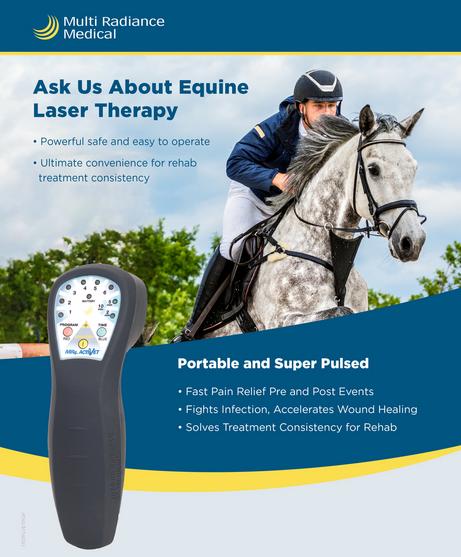Equine Therapy Success Stories: Genuine Individuals, Genuine Psychological Improvements
Equine Therapy Success Stories: Genuine Individuals, Genuine Psychological Improvements
Blog Article
Laser Therapy in Horse Therapy: A Modern Approach to Improving Steed Health And Wellness
Laser therapy has actually emerged as a crucial method in equine treatment, using focused light energy to promote cellular repair service and speed up recuperation from a variety of disorders. This non-invasive technique is specifically effective in managing musculoskeletal injuries, wounds, and inflammatory problems, significantly improving general steed wellness. By promoting mitochondrial activity and boosting ATP production, laser therapy not just improves blood circulation but likewise gives significant pain relief. As this cutting-edge therapy continues to acquire grip, it opens up interesting possibilities for dealing with chronic conditions like arthritis and unguis troubles, signifying a transformative shift in vet care. What makes this technique specifically engaging?
Understanding Laser Therapy
Laser therapy, a non-invasive treatment technique, has gained considerable grip in equine medication as a result of its efficiency in advertising healing and pain alleviation. This advanced therapeutic approach makes use of focused light power to permeate cells, cultivating cellular repair and regrowth. The underlying system entails the excitement of mobile mitochondria, leading to boosted production of adenosine triphosphate (ATP), the power currency of cells. Enhanced ATP degrees speed up tissue repair procedures and minimize inflammation, making laser treatment particularly efficient for treating musculoskeletal injuries, wounds, and other inflammatory problems in horses.
There are numerous sorts of lasers utilized in equine therapy, each with details wavelengths and power outcomes customized to various therapeutic demands. Low-level laser therapy (LLLT), also known as chilly laser therapy, utilizes reduced power degrees to promote cell function without causing thermal damages. High-intensity laser treatment (HILT), in comparison, uses greater power levels to attain much deeper tissue penetration and more considerable healing impacts.
Veterinarians utilize different laser gadgets and methods depending on the condition being dealt with and the preferred depth of tissue penetration. Appropriate training and knowledge are vital for ensuring the secure and efficient application of laser treatment, thereby optimizing its restorative capacity while reducing risks.
Advantages for Horse Health
With a solid understanding of exactly how laser treatment works, it is important to discover its numerous advantages for equine wellness. By boosting cellular function, laser treatment promotes faster injury healing and aids in the regeneration of broken tissues.
In addition, laser therapy has actually been revealed to boost flow, thereby boosting blood circulation to influenced areas. Improved blood circulation guarantees that crucial nutrients and oxygen are supplied more efficiently, promoting the recovery procedure. Additionally, laser treatment's anti-inflammatory results aid in reducing swelling and pain, which is vital for the total well-being of the horse.
Discomfort management is another significant advantage. By launching endorphins and blocking discomfort signals, laser treatment provides effective, non-invasive alleviation from both acute and persistent pain. This can contribute to enhanced flexibility and lifestyle for the pet.
Last but not least, laser treatment is a non-invasive therapy choice, minimizing the danger of issues related to more invasive procedures. Its flexibility and efficacy make it an invaluable tool in modern equine vet medicine.
Usual Conditions Treated

Another widespread Check Out Your URL problem treated with laser therapy is arthritis. In addition, laser treatment is utilized in the administration of wounds.
Equine breathing conditions, such as reoccurring air passage blockage (RAO), also respond positively to laser treatment. The anti-inflammatory homes of the therapy help in lowering respiratory tract inflammation, hence enhancing respiratory function. Furthermore, laser treatment is beneficial in dealing with hoof issues, consisting of laminitis and abscesses. By enhancing circulation and minimizing discomfort, it sustains quicker recuperation.
Treatment and Security
Applying laser treatment in equine therapy involves a thorough treatment to make sure both effectiveness and safety and security. Equine Therapy. The procedure starts with a complete veterinary analysis to determine the suitability of laser therapy for the equine's particular problem. As soon as deemed appropriate, the treatment area is prepared by cleaning and, if needed, clipping the hair to improve laser penetration
The professional should select the proper kind of laser, normally a low-level laser (LLLT) or a high-power laser (HPL), relying on the condition being treated. The laser gadget is after that adjusted to the appropriate wavelength, power, and duration settings. During the application, the professional relocates the laser over the targeted location in a systematic manner, making sure regular and also direct exposure.
Safety protocols are strictly abided by, consisting of using safety eyewear for both the practitioner and the horse. Furthermore, it is vital to check the horse for any signs of discomfort or negative responses throughout the procedure. Post-treatment, the steed is usually provided a duration of rest to enable the therapeutic impacts to show up.

Future of Equine Laser Treatment
As innovations in vet medicine remain to unfold, the future of equine laser treatment holds considerable guarantee. Emerging modern technologies and much deeper scientific insights are established to fine-tune and expand the applications of laser treatment for equines. One of the most awaited advancements is the integration of advanced imaging strategies that enable for more his comment is here precise targeting of damaged tissues, thereby boosting therapeutic end results. Furthermore, the development of mobile and easy to use laser devices is most likely to make this treatment extra easily accessible to a broader array of specialists and horse owners.
Furthermore, recurring research right into the molecular and mobile devices of laser treatment will likely yield enhanced protocols tailored to details conditions, enhancing performance and decreasing therapy times. Individualized treatment plans based upon hereditary and biochemical markers might come to be a reality, making sure that each steed receives the most proper and reliable care.
Additionally, regulative innovations and standardization of protocols will improve the credibility and reliability of laser therapy in equine technique. Equine Therapy. As these innovations remain to emerge, equine laser therapy is positioned to come to be an essential element of veterinary care, offering improved recovery and boosted lifestyle for steeds globally
Conclusion

Report this page